
The New Zealand and South Seas Exhibition was an international exhibition held in Dunedin, New Zealand from 26 November 1889 to 19 April 1890.

Dunedin is the second-largest city in the South Island of New Zealand, and the principal city of the Otago region. Its name comes from Dùn Èideann, the Scottish Gaelic name for Edinburgh, the capital of Scotland. The city has a rich Māori, Scottish, and Chinese heritage.
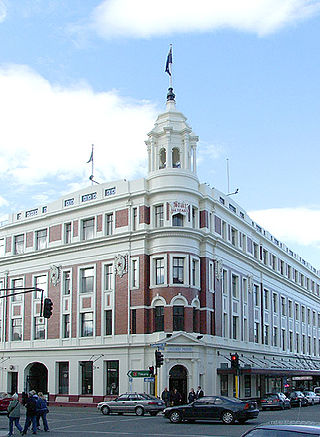
The Otago Daily Times (ODT) is a newspaper published by Allied Press Ltd in Dunedin, New Zealand. The ODT is one of the country's four main daily newspapers, serving the southern South Island with a circulation of around 26,000 and a combined print and digital annual audience of 304,000. Founded in 1861 it is New Zealand's oldest surviving daily newspaper – Christchurch's The Press, six months older, was a weekly paper until March 1863.
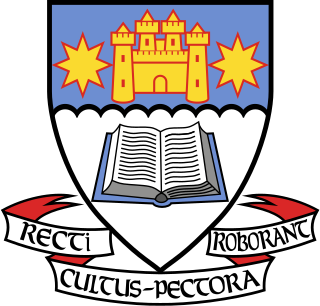
Otago Boys' High School (OBHS) is a secondary school in Dunedin, New Zealand. It is one of New Zealand's oldest boys' secondary schools. Originally known as Dunedin High School, it was founded on 3 August 1863 and moved to its present site in 1885. The main building was designed by Robert Lawson and is regarded as one of the finest Gothic revival structures in the country. Situated on high ground above central Dunedin it commands excellent views of the city and is a prominent landmark.
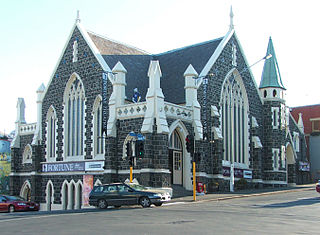
New Zealand's Fortune Theatre laid claim to being the world's southernmost professional theatre company and sole year round professional theatre group in Dunedin, until its closure on 1 May 2018, citing financial difficulties. The company ran for 44 years. The theatre regularly produced local shows and hosted touring performances.

The Octagon is the city centre of Dunedin, in the South Island of New Zealand. It is an eight-sided plaza with a circular one-way carriageway, bisected by the city's main street, and is also the central terminus of two other main thoroughfares. The Octagon is predominantly a pedestrian reserve, with grass and paved features, and is surmounted by a statue of the Scottish poet Robert Burns. Several of Dunedin's significant buildings and institutions adjoin the plaza, which is also a major hub for public transport in Dunedin, primarily taxi services.

Princes Street is a major street in Dunedin, the second largest city in the South Island of New Zealand. It runs south-southwest for two kilometres from The Octagon in the city centre to the Oval sports ground, close to the city's Southern Cemetery. North of The Octagon, George Street continues the line of Princes Street north-northeast for two and a half kilometres. Princes Street is straight but undulating, skirting the edge of the City Rise to its northwest. The part of the street immediately below The Octagon is the steepest section, as the road traverses an old cutting through Bell Hill.

Moray Place is an octagonal street which surrounds the city centre of Dunedin, Otago, New Zealand. The street is intersected by Stuart Street, Princes Street and George Street. Like many streets in Dunedin, it is named for a street in the Scottish capital Edinburgh.

The Dunedin Public Art Gallery holds the main public art collection of the city of Dunedin, New Zealand. Located in The Octagon in the heart of the city, it is close to the city's public library, Dunedin Town Hall, and other facilities such as the Regent Theatre.

The Edgar Centre is a large multi-purpose indoor sports venue in South Dunedin, New Zealand, on the shore of Otago Harbour close to Andersons Bay Inlet. It is the home venue of the Otago Nuggets basketball team, and an alternate venue for the Southern Steel netball team. The centre also hosts a wide variety of other sports events and community events such as auctions and fairs, and is owned by the Dunedin City Council. Since 2023, it has been the site of the annual Regent Book Sale.

Dunedin Hospital is the main public hospital in Dunedin, New Zealand. It serves as the major base hospital for the Otago and Southland regions with a potential catchment radius of roughly 300 kilometres, and a population of around 300,000.

Globe Theatre is a theatre located in Dunedin, New Zealand, and the amateur theatre company that runs it. The theatre was built in 1961 by Patric and Rosalie Carey as an extension of their house. The building to which it is attached, at 104 London Street, was designed by architect William Mason as his own house and built in 1864. Ralph Hotere designed both sets and costumes for the theatre productions. The foyer area was also used for exhibitions, notably the Waterfall paintings of Colin McCahon, paintings by Michael Smither, and pots by Barry Brickell, Len Castle, and Doreen Blumhardt.
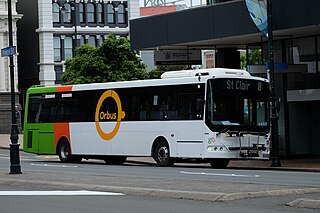
The public transport system of Otago centres around the cities of Dunedin and Queenstown, under the brand name Orbus. Public transport in the region is provided using buses and ferries. Despite sharing a name, the systems in Dunedin and Queenstown are isolated from one another.

The Dunedin Town Hall, also known as the Dunedin Centre, is a municipal building in the city of Dunedin in New Zealand. It is located in the heart of the city extending from The Octagon, the central plaza, to Moray Place through a whole city block. It is the seat of the Dunedin City Council, providing its formal meeting chamber, as well as a large auditorium and a conference centre. The oldest part of the building has been called the only substantial Victorian town hall still in existence in New Zealand.

The Dunedin Fringe Festival, or Dunedin Fringe, is an 11-day fringe arts festival held each March in Dunedin, New Zealand. Initiated in the year 2000, Dunedin Fringe aims to bring experimental contemporary art to a wider audience and to support the work of emerging artists, attracting artists from throughout New Zealand and overseas.

Henry Eli White, also known as Harry White, was a New Zealand-born architect best known for the many theatres and cinemas he designed in New Zealand and Australia in the 1910s and 1920s. Many of the major surviving historic venues in the two countries are White designs, including the St. James Theatre, Wellington, St. James Theatre, Auckland, the Capitol Theatre and State Theatre in Sydney, and the Palais Theatre and the interiors of the Princess Theatre and Athenaeum Theatre in Melbourne. He also designed the City Hall and the attached Civic Theatre in Newcastle, New South Wales.

Abraham Gabriel Gray is an American-born New Zealand cannabis activist, politician and founder of the Whakamana Cannabis Museum, New Zealand's first and only cannabis museum. Gray was a University of Otago lecturer and tutor for over a decade before founding the museum.

Dunedin Athenaeum and Mechanics' Institute is an adult education institute based in a heritage building in Dunedin, New Zealand. The private organisation provided classes and a library for members. Presently it operates a subscription lending library, and includes a basement theatre that has been operated by the Dunedin Collaborative Theatre Trust since 2016. The Athenaeum building is one of the oldest athenaeums in New Zealand still used for its original purpose, and is classified as a "Category I" historic place by Heritage New Zealand Pouhere Taonga, previously known as the New Zealand Historic Places Trust.
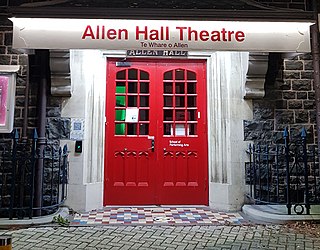
Allen Hall, also known as the Allen Hall Theatre, is a building at the University of Otago in Dunedin, New Zealand. It is named after James Allen, Vice-Chancellor and then Chancellor of the university, who was instrumental in raising funds for building the hall. Originally the student association building, opened in 1914, the hall now operates as a theatre. Allen Hall is known for the series of Lunchtime Theatre performances. The hall and archway are registered as a Category I historic place by Heritage New Zealand.

New Zealand performing arts venues are places in New Zealand that are set up to host performing arts and music events such as theatre, dance and concerts.






















